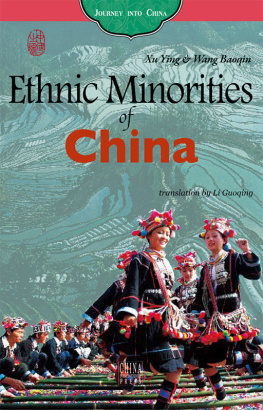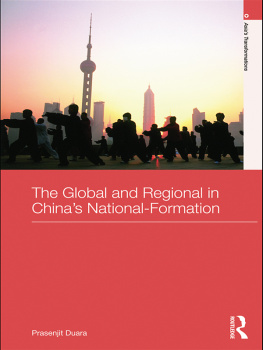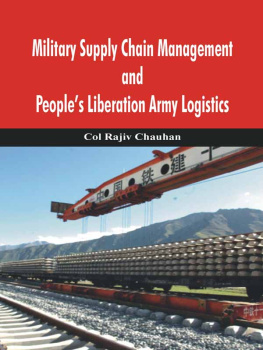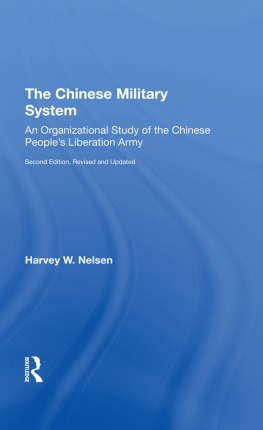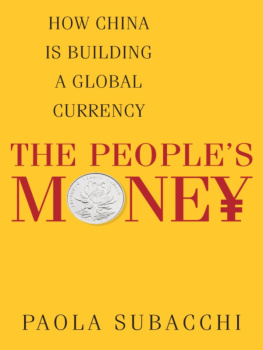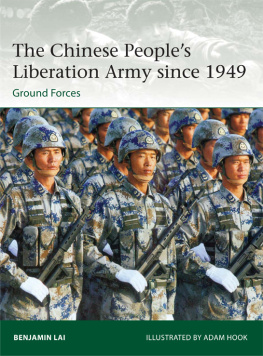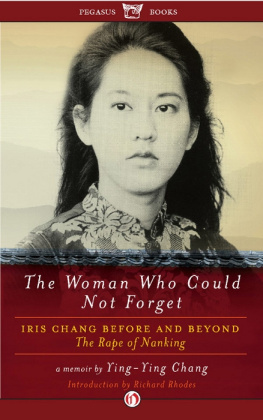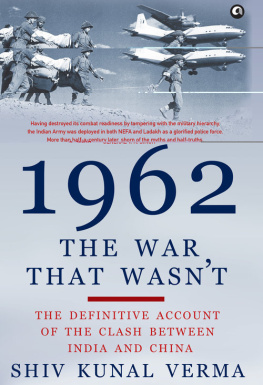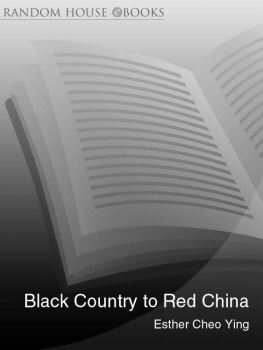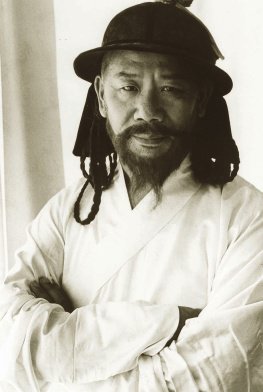The People's Liberation Army and China's Nation-Building
The People's Liberation Army and China's Nation-Building
Ying-Mao Kau
First published 1973 by International Arts and Sciences Press, Inc.
Reissued 2018 by Routledge
2 Park Square, Milton Park, Abingdon, Oxon OX14 4RN
711 Third Avenue, New York, NY 10017, USA
Routledge is an imprint of the Taylor & Francis Group, an informa business
Copyright 1973 by Taylor & Francis
No part of this book may be reprinted or reproduced or utilised in any form or by any electronic, mechanical, or other means, now known or hereafter invented, including photocopying and recording, or in any information storage or retrieval system, without permission in writing from the publishers.
Notices
No responsibility is assumed by the publisher for any injury and/or damage to persons or property as a matter of products liability, negligence or otherwise, or from any use of operation of any methods, products, instructions or ideas contained in the material herein.
Practitioners and researchers must always rely on their own experience and knowledge in evaluating and using any information, methods, compounds, or experiments described herein. In using such information or methods they should be mindful of their own safety and the safety of others, including parties for whom they have a professional responsibility.
Product or corporate names may be trademarks or registered trademarks, and are used only for identification and explanation without intent to infringe.
Publisher's Note
The publisher has gone to great lengths to ensure the quality of this reprint but points out that some imperfections in the original copies may be apparent.
Disclaimer
The publisher has made every effort to trace copyright holders and welcomes correspondence from those they have been unable to contact.
A Library of Congress record exists under LC control number: 72077203
ISBN 13: 978-0-873-32006-1 (hbk)
ISBN 13: 978-1-315-17939-1 (ebk)
To Lea E. Williams
and the East Asia Language
and Area Center, Brown University
Data collected by the United States Arms Control and Disarmament Agency reveal that a total of approximately 24 million men are under arms today in the world, and more than $210 billion is spent each year in direct support of military forces. On the average, military expenditures consume roughly 20 percent of the national budget of every country. These staggering figures raise an obvious and serious question: How can this enormous military manpower and these resources be used for the constructive purposes of nation-building and modernization? The question is of particular significance to the developing countries of the "Third World," where material and human resources available for development are scarce, while expectations and demands for modernization are high. The probe into the feasibility of harnessing and converting armed forces into a vehicle of modernization and nation-building clearly goes beyond the confines of academic interests.
Historical evidence throughout the world, however, shows that efforts to enlist the military for the performance of nonmilitary tasks carry certain risks and consequences. Such attempts tend to upset the proper balance of civil-military relations, especially the ideal of civilian supremacy and control of the military. Calling on the armed forces to share power or form a partnership in domestic politics for the purpose of sustaining the political system in crisis often leads to a military takeover of the civilian government. Attempts to utilize the organizational and technical skills of the military for economic development and social modernization frequently introduce military men into the arena of power and policy struggles and eventually prompt the generals to intervene militarily.
Without appropriate normative and organizational arrangements, encouraging the military, intentionally or unintentionally, to play an expanded role in civilian affairs can invite unanticipated disasters. The ubiquity of military coups, praetorian rule, and army dictatorships in the developing countries today clearly attests to this phenomenon. In 1965 alone, for instance, as many as fifty-seven cases of large-scale military revolts, armed insurgencies, and military coups d'etat were reported, in which the military succeeded in imposing praetorian control in eleven countries. The results are clear: A civilian government attempting to tap the resources of the military without being victimized by the expanded power and role of the military incurs a great challenge and high risks.
The Chinese experience, in which the Communist leadership has actively and effectively used its armed forces, the People's Liberation Army (PLA), for a wide variety of extramilitary purposes, deserves close attention. Organized on the basis of Mao's theory of "people's war," the Communist Red Army has, since the late 1920s, functioned successfully, as Mao put it, both as a "fighting force" and as a "working force." It fought and won one of the greatest revolutionary wars in human history, played an active role in the creation of Communist power in China, and participated extensively and effectively in economic and social transformation. It was not only during the periods of protracted guerrilla movements that the extramilitary role of the PLA was conspicuous; it was equally evident in the years of postliberation construction. Although on a few occasions the Maoist principle that "the Party commands the gun and the gun shall never be allowed to command the Party" was challenged by military leaders, Mao has managed to avert the crises of military domination or takeover. Evidence to date indicates that Mao has succeeded to a great extent in developing a unique formula of ideological and organizational control capable of effectively using the military for nation - building.
The purpose of this volume is to present, in the Chinese leadership's own words and conceptualization, the Chinese model of army-building and its contributions to the political development and socioeconomic modernization of China. Special emphasis is placed on the historical roots and organizational characteristics of the model, and on the scope of extra military activities. The operational dynamics of the model within the broad context of China's changing political and social systems is also examined in light of the growing challenges to Mao's military thinking stemming from the changes and developments within and outside the PLA as a societal institution.
The documents and writings selected for this book are broadly organized into three parts. The first part (section I) traces the origins of Mao's military doctrines and identifies, in Mao's own words, the major characteristics of the model he has constructed. The second part (sections II-V) covers the specific categories of extramilitary roles that the PLA performs. The selections in this part also deal with the organizational principles and leadership techniques devised by Mao to guarantee the effective performance of the functions assigned to the military. The last part (sections VI-VIII) emphasizes the operational dynamics of the model since 1949, highlighting on the one hand, the struggle between "two lines" and the challenges of military professionalism and military power, and on the other hand, the persistence of the Maoist line of military-building. The editor's introductory essay offers a comprehensive analysis of the development and operation of the Maoist model from historical and theoretical perspectives. It also ties the materials together into a coherent whole focusing on the special role in China's mass-mobilization approach to nation-building of the Chinese military. Owing to the limitations of space, materials that fall within the scope of military training, tactics, and strategy are not included. Fortunately, most of these materials written by Mao himself have been made conveniently available in the Selected Military Writings of Mao Tse-tung (Peking: Foreign Languages Press, 1963).




